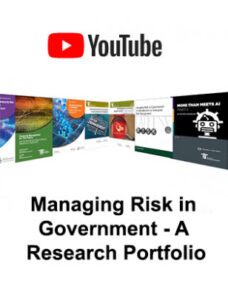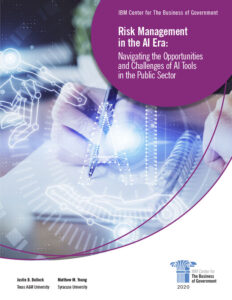This Resource has been removed due to a citation error.

This Resource has been removed due to a citation error.
What are benefits of pursuing enterprise risk management? How can risk management enhance agency decision-making? What is the mission of the Association for Federal Enterprise Risk Management (AFERM)? Join host Michael Keegan as he explores these questions and more with our very special guest, Tom Brandt, Chief Risk Officer, at the US Internal Revenue Service (IRS).

Risk is everywhere.
It is a condition of existence and government agencies aren’t immune from the slings and arrows of uncertainty. Risk takes many forms and continue to morph and transform with the pace of technology and the reality interconnectedness. It is a leadership imperative for government executives to mitigate the potency of uncertainty by managing the realities of risk and the IBM Center can help them…mitigate risk and make better decisions. Tackling risks requires the right tools and recognized best practices. Dr. Karen Hardy’s report outlines the fundamentals of enterprise risk management ERM in government…answering the how to and the why not? The first step in tackling risk is defining it and it isn’t always negative. Risk can present opportunities. Government Leaders can redefine risk as “uncertainty that matters” and Dr. Doug Webster and Tom Stanton can show you how… outlining practical steps to improving decision making using ERM. Many federal programs are at risk unable or incapable to achieving missions mitigating program risk is key to making government work better. Prof Donald Kettl report, provides a guide of steps risky federal programs can take to manage risk, improve results. Whether you face …. Integrity Risk Financial Risk Cyber Risks Or, risks associated with technological breakthroughs and disruptions…
This video provides an overview of many IBM Center for The Business of Government resources on risk.
 Artificial Intelligence (AI) has moved into the mainstream of businesses and government.
Artificial Intelligence (AI) has moved into the mainstream of businesses and government.
Business leaders are rushing to take advantages of the benefits that can be brought to a wide array of industries to help increase productivity. Government leaders are also moving forward, but with appropriate caution. When considering the use and application of AI related technologies, government leaders weigh different factors than their private sector counterparts. Whether it is deploying self-driving electric trolleys in a city or retrofitting city streetlights with sensors to make them “smarter,” these leaders must address issues of accountability, transparency, ethics, equity, common good, effectiveness, efficiency, managerial capacity, and political legitimacy.
The report authors put forth a threefold strategy to assist government leaders and public managers with how best to approach using AI, which includes:
The authors close with a list of practical guidelines for government action in using AI tools to improve the overall quality of governance, while incorporating similar tools into their overall risk management strategy.
The purpose of this form is to provide a consistent framework for the Service that can be leveraged within a unit’s existing governance or management approval processes to clearly document business decisions in the context of risk appetite and/or acceptance. This document can be used in various ways, including the following:
1) a framework to assess various options in making decisions for achievement of objectives,
2) a guide to articulate rationale behind those decisions within the context of risk appetite, and
3) a documentation trail to support these business decisions. Refer to the end of this document for instructions and additional guidance regarding use of the tool.
For this tool, right-click and save the document to your computer for full use.
This flyer outlines the value that Enterprise Risk Management (ERM) can provide to government leaders.
The Enterprise Risk Channel provides a mechanism for employees to send potential risks to the Office of the Chief Risk Officer on a confidential basis. This sample form has been provided by the IRS.
Several recent reports and studies have detailed a range of worsening trends and developments that are creating an increased risk for significant government failure. Many of the reports offer recommendations for action by Congress and the Administration. However, they do not go as far to suggest and recognize what agency leaders can do, and in many cases are doing, to help address these challenges. This paper, from the Senior Executives Association (SEA) and the Association for Federal Enterprise Risk Management (AFERM), aims to highlight how agency leaders can use enterprise risk management to reduce the risk of government failure while increasing the likelihood for the successful delivery of agency missions.
 On April 16, 2018, the Association of Government Accountants (AGA) and the Association for Federal Enterprise Risk Management (AFERM) held the second annual enterprise risk management (ERM) workshop with federal government professionals. This workshop provided an opportunity for over 150 professionals to hear ERM thought leadership from senior government leaders and discuss with their colleagues how ERM can, and is, driving organizational value and enhancing performance. This summary report shares the information discussed during this workshop.
On April 16, 2018, the Association of Government Accountants (AGA) and the Association for Federal Enterprise Risk Management (AFERM) held the second annual enterprise risk management (ERM) workshop with federal government professionals. This workshop provided an opportunity for over 150 professionals to hear ERM thought leadership from senior government leaders and discuss with their colleagues how ERM can, and is, driving organizational value and enhancing performance. This summary report shares the information discussed during this workshop.
